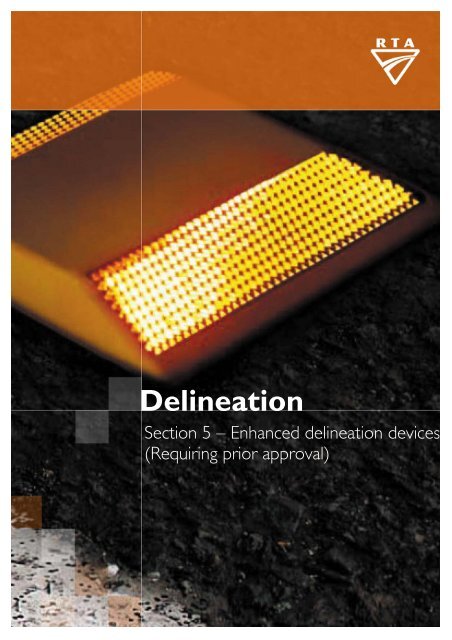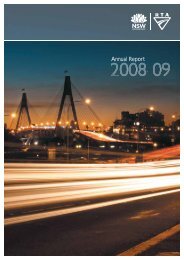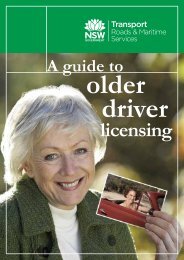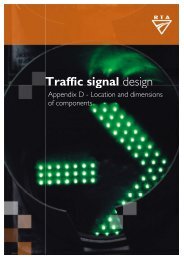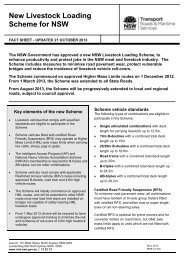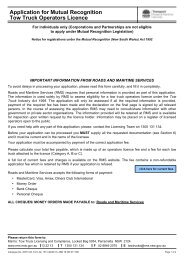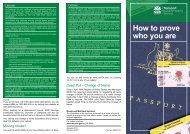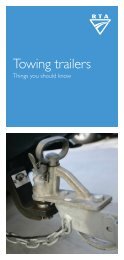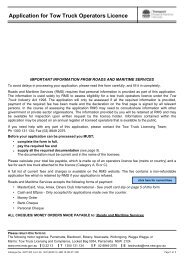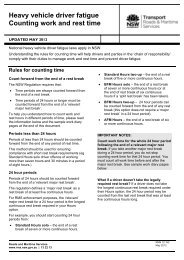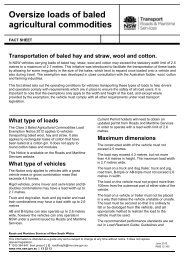Requiring prior approval - RTA
Requiring prior approval - RTA
Requiring prior approval - RTA
You also want an ePaper? Increase the reach of your titles
YUMPU automatically turns print PDFs into web optimized ePapers that Google loves.
Delineation<br />
Section 5 – Enhanced delineation devices<br />
(<strong>Requiring</strong> <strong>prior</strong> <strong>approval</strong>)
The delineation guidelines have been developed to assist in designing and maintaining a quality<br />
delineation system.<br />
The guidelines are to comprise 19 sections and an appendix. These are initially being released<br />
individually and in no specific order. The sections which are to be released are as follows:<br />
Part<br />
Section 1<br />
Section 2<br />
Section 3<br />
Section 4<br />
Section 5<br />
Section 6<br />
Section 7<br />
Section 8<br />
Section 9<br />
Section 10<br />
Section 11<br />
Section 12<br />
Section 13<br />
Section 14<br />
Section 15<br />
Section 16<br />
Section 17<br />
Section 18<br />
Section 19<br />
Appendix A<br />
Title<br />
Introduction<br />
Delineation principles<br />
Pavement markings<br />
Longitudinal markings<br />
Enhanced longitudinal markings<br />
Transverse markings<br />
Transverse markings - Pedestrian facilities<br />
Diagonal and chevron markings<br />
Messages on pavements<br />
Pavement arrows<br />
Pavement markings at roundabouts<br />
Pavement markings for bicycle facilities<br />
Pavement markings for kerbside parking restrictions<br />
Maintenance of pavement markings<br />
Raised pavement markers<br />
Guide posts and delineation of safety barriers<br />
Alignment signs and markers<br />
Delineation systems<br />
Delineation management and audit<br />
Locating and setting out of dividing (barrier) lines<br />
To determine which sections are currently available go to:<br />
www.rta.nsw.gov.au/doingbusinesswithus/downloads/technicalmanuals/delineation_dl1.html<br />
The information contained in the various parts is intended to be used as a guide to good practice.<br />
Discretion and judgement should be exercised in the light of the many factors that may influence<br />
the choice of delineation devices in any situation. The guidelines make reference, where relevant,<br />
to current Australian Standards and are intended to supplement and otherwise assist in their<br />
interpretation and application.
Delineation<br />
Section 5<br />
ENHANCED<br />
DELINEATION DEVICES<br />
(<strong>Requiring</strong> <strong>prior</strong> <strong>approval</strong>)<br />
Special Note:<br />
As from 17 January 2011, the <strong>RTA</strong> is adopting the Austroads Guides (Guide to Traffic<br />
Management) and Australian Standards (AS 1742, 1743 & 2890) as its primary technical<br />
references.<br />
An <strong>RTA</strong> Supplement has been developed for each Part of the Guide to Traffic Management<br />
and relevant Australian Standard. The Supplements document any mandatory <strong>RTA</strong> practice<br />
and any complementary guidelines which need to be considered.<br />
The <strong>RTA</strong> Supplements must be referred to <strong>prior</strong> to using any reference material.<br />
This <strong>RTA</strong> document is a complementary guideline. Therefore if any conflict arises, the <strong>RTA</strong><br />
Supplements, the Austroads Guides and the Australian Standards are to prevail.<br />
The <strong>RTA</strong> Supplements are located on the <strong>RTA</strong> website at www.rta.nsw.gov.au<br />
Version 1.5<br />
UNCONTROLLED WHEN PRINTED
Roads and Traffic Authority<br />
www.rta.nsw.gov.au<br />
VERSION: 1.0<br />
ISSUED: April 2008<br />
AMENDMENTS: Refer to Amendment Record<br />
APPROVED BY:<br />
SIGNED<br />
Phil Margison<br />
General Manager<br />
Traffic Management<br />
SIGNED<br />
Steve Levett<br />
A/General Manager<br />
Safer Roads<br />
AUTHORISED FOR USE BY:<br />
SIGNED<br />
Michael Bushby<br />
Director<br />
Network Management<br />
© 2008 Roads and Traffic Authority NSW<br />
Extracts from these guidelines may be reproduced providing<br />
the subject is kept in context and the source is acknowledged.<br />
Every effort has been made to supply complete and accurate<br />
information. However <strong>RTA</strong>, NSW assumes no responsibility for its use.<br />
All trade name references herein are either trademarks or<br />
registered trademarks of their respective companies.<br />
For policy and technical enquiries regarding these guidelines please contact:<br />
Traffic Management Branch<br />
Email: technical_directions_publication@rta.nsw.gov.au<br />
To access electronic copies of these and other guidelines go to:<br />
www.rta.nsw.gov.au/doingbusinesswithus/downloads/technicalmanuals/technicalmanuals_dl1.html<br />
For the latest amendments (if any) to these guidelines go to:<br />
www.rta.nsw.gov.au/doingbusinesswithus/downloads/technicalmanuals/delineation_dl1.html<br />
ISBN 978-1-921242-89-2 (Electronic only)<br />
<strong>RTA</strong>/Pub. 08.091<br />
ii Version 1.5<br />
UNCONTROLLED WHEN PRINTED
Delineation – Section 5 Enhanced delineation devices (<strong>Requiring</strong> <strong>prior</strong> <strong>approval</strong>)<br />
Contents<br />
5.1 Special Approval ..........................................................................5-1<br />
5.2 Enhanced pavement markings ...................................................5-1<br />
5.2.1 General.................................................................................................................5-1<br />
5.2.2 Enhanced dividing (separation) lines (S3) .....................................................5-1<br />
5.2.3 Enhanced dividing (barrier) lines (BS1, BB1 and BB2) ...............................5-3<br />
5.2.4 Enhanced unbroken lane lines (L5)................................................................5-6<br />
5.2.5 Enhanced broken profile lane line (L2) .........................................................5-7<br />
5.2.6 Profile linemarking .............................................................................................5-9<br />
5.3 Enhanced lane separation devices ...........................................5-15<br />
5.3.1 General...............................................................................................................5-15<br />
5.3.2 Devices...............................................................................................................5-15<br />
5.3.3 Use ......................................................................................................................5-15<br />
5.4 Delineation devices for tidal flow management.....................5-18<br />
5.4.1 General...............................................................................................................5-18<br />
5.4.2 Devices...............................................................................................................5-18<br />
5.4.3 Use ......................................................................................................................5-20<br />
5.5 Lane Usage Signs .......................................................................5-21<br />
5.5.1 General...............................................................................................................5-21<br />
5.5.2 Use ......................................................................................................................5-21<br />
5.6 Transverse line marking as a perceptual counter measure to<br />
speeding ......................................................................................5-22<br />
5.6.1 General...............................................................................................................5-22<br />
5.6.2 Rumble strips ....................................................................................................5-22<br />
5.6.3 Use ......................................................................................................................5-23<br />
5.7 Enhanced Safety Barrier Delineation ......................................5-26<br />
5.7.1 General...............................................................................................................5-26<br />
5.7.2 Use ......................................................................................................................5-26<br />
5.7.3 Material Requirements....................................................................................5-26<br />
5.7.4 Guidelines..........................................................................................................5-26<br />
5.7.5 Devices...............................................................................................................5-26<br />
Version 1.5<br />
UNCONTROLLED WHEN PRINTED<br />
iii
Delineation – Section 5 Enhanced delineation devices (<strong>Requiring</strong> <strong>prior</strong> <strong>approval</strong>)<br />
Figures<br />
Figure 5.1:<br />
Figure 5.2:<br />
Enhanced dividing (separation) line (S3)..........................................5-2<br />
Enhanced dividing (barrier) line (BS1).............................................5-5<br />
Figure 5.3: Enhanced dividing (barrier) line (BB1) ............................................5-5<br />
Figure 5.4: Enhanced dividing (barrier) line (BB2) ............................................5-6<br />
Figure 5.5:<br />
Enhanced Lane line (L5).................................................................5-7<br />
Figure 5.6: Profile lane line (L2) ......................................................................5-8<br />
Figure 5.7:<br />
Figure 5.8:<br />
Raised ribs across profile linemarking.............................................5-9<br />
Type A Profile linemarking...........................................................5-10<br />
Figure 5.9: Type B Profile linemarking ...........................................................5-10<br />
Figure 5.10: Profile line on Motorways and Dual Carriageways ........................5-11<br />
Figure 5.11: Enhanced lane separation devices (Pavement flaps) .......................5-17<br />
Figure 5.12:<br />
Figure 5.13:<br />
Enhanced lane separation devices (Collapsible delineator).............5-17<br />
Enhanced lane separation devices (Flexible bollards).....................5-17<br />
Figure 5.14: A typical movable median unit .....................................................5-19<br />
Figure 5.15: Application of Typical Tidal Flow Devices (overhead gantries) ......5-19<br />
Figure 5.16: Application of Typical Tidal Flow Devices (remotely controlled<br />
moveable median)........................................................................5-20<br />
Figure 5.17:<br />
Application of Lane Usage Signs (LUS)..........................................5-22<br />
Figure 5.18: Recommended rumble strip pattern on intersection approach for<br />
≥100 km/h approach speed ..........................................................5-25<br />
Figure 5.19: Application of enhanced Safety Barrier treatment – W Beam ........5-27<br />
Figure 5.20:<br />
Application of enhanced Safety Barrier treatment – Concrete<br />
Barrier.........................................................................................5-27<br />
iv Version 1.5<br />
UNCONTROLLED WHEN PRINTED
Delineation – Section 5 Enhanced delineation devices (<strong>Requiring</strong> <strong>prior</strong> <strong>approval</strong>)<br />
Figure 5.21:<br />
Application of enhanced Safety Barrier treatment – Central Concrete<br />
Barrier.............................................................................................................5-28<br />
Figure 5.22:<br />
Dimensions of Yellow Retroreflective Chevron – Central Concrete<br />
Barrier.............................................................................................................5-28<br />
Tables<br />
Table 5.1:<br />
Basic Features of Enhanced Dividing Lines.........................................5-3<br />
Table 5.2: Enhanced Dividing (separation & barrier) lines ..................................5-4<br />
Table 5.3:<br />
Table 5.4:<br />
Enhanced Lane Line (L5)...................................................................5-6<br />
Enhanced Lane Line (L2)...................................................................5-8<br />
Version 1.5<br />
UNCONTROLLED WHEN PRINTED<br />
v
Delineation – Section 5 Enhanced delineation devices (<strong>Requiring</strong> <strong>prior</strong> <strong>approval</strong>)<br />
Amendment record<br />
Please note that the following updates have been made to this document.<br />
Amendment<br />
No<br />
Page Description Issued Approved<br />
By<br />
1 5-16 Requirement for <strong>approval</strong> in 5.3.2 November R O’Keefe<br />
clarified.<br />
2009 Mgr Policies &<br />
Guidelines<br />
2 5-11 Profile line for other roads deleted December<br />
2010<br />
R O’Keefe<br />
Mgr Traffic<br />
Policies,<br />
Guidelines &<br />
3 5-26,<br />
5-27<br />
4 5-26,<br />
5-27<br />
New Section 5.7 Enhanced Safety<br />
Barrier Delineation added<br />
Width of delineation corrected<br />
5 5-26 New Section 5.7.5.3 Enhanced Safety<br />
Barrier Delineation – Central<br />
Concrete Barrier added.<br />
February<br />
2012<br />
March<br />
2012<br />
May<br />
2013<br />
Legislation<br />
R O’Keefe<br />
Mgr Traffic<br />
Policies,<br />
Guidelines &<br />
Legislation<br />
R O’Keefe<br />
Mgr Traffic<br />
Policies,<br />
Guidelines &<br />
Legislation<br />
R O’Keefe<br />
Mgr Traffic<br />
Policies,<br />
Guidelines &<br />
Legislation<br />
vi Version 1.5<br />
UNCONTROLLED WHEN PRINTED
Delineation – Section 5 Enhanced delineation devices (<strong>Requiring</strong> <strong>prior</strong> <strong>approval</strong>)<br />
5.1 Special Approval<br />
Standard delineation devices should be used on all <strong>RTA</strong> roads. However, in<br />
exceptional circumstances, there may be a case when enhanced delineation<br />
devices may sometimes be needed. Prior <strong>approval</strong> of the General Manager,<br />
Traffic Management is required for installing enhanced delineation devices<br />
prescribed in this section, except for the use of perceptual counter<br />
measures (Section 5.6), for which <strong>approval</strong> of the General Manager, Safer<br />
Roads, is also required.<br />
5.2 Enhanced pavement markings<br />
5.2.1 General<br />
The following circumstances may warrant the use of enhanced pavement<br />
markings:<br />
(a)<br />
(b)<br />
(c)<br />
(d)<br />
To achieve greater separation between opposing traffic (dividing<br />
line)<br />
To present a more forceful deterrent to changing lanes (unbroken<br />
lane line)<br />
To improve the conspicuity of the painted lines and provide an<br />
enhanced road preview time (all lines)<br />
To control speeding on approaches to a hazard (perceptual<br />
countermeasure)<br />
The enhanced pavement markings do not alter or enhance the legal<br />
significance of the line. These lines provide more forceful visual clues and<br />
/or impart greater separation between opposing traffic.<br />
5.2.2 Enhanced dividing (separation) lines (S3)<br />
5.2.2.1 Description and use<br />
Enhanced dividing (separation) line (S3) is a 200 mm wide broken line as<br />
compared to the 100 mm width of the standard S1 line. It should be used<br />
where greater separation is required between opposing streams of traffic<br />
(See Table 5.1 for separation widths that can be achieved) and where<br />
overtaking is permitted in both directions.<br />
Version 1.5 5-1<br />
UNCONTROLLED WHEN PRINTED
Delineation – Section 5 Enhanced delineation devices (<strong>Requiring</strong> <strong>prior</strong> <strong>approval</strong>)<br />
Pattern and dimensions of enhanced dividing (separation) lines are shown in<br />
Table 5.2. They are supplemented with a staggered raised pavement<br />
marker pattern (see Section 15 for marker pattern).<br />
5.2.2.2 Guidelines<br />
Enhanced dividing (separation) lines must only be used, where:<br />
(a)<br />
(b)<br />
(c)<br />
Minimum width for a two-lane carriageway is 7 m plus a minimum<br />
width of existing sealed shoulders of 0.5 m each is available, and<br />
AADT volumes are at least 2000 vehicles per day, and<br />
There is demonstrated evidence (supported by crash records) that<br />
the standard S1 line is inadequate in separating opposing traffic.<br />
5.2.2.3 Applications<br />
Application of enhanced dividing line (S3) is illustrated below –<br />
Figure 5.1:<br />
Enhanced dividing (separation) line (S3)<br />
5-2 Version 1.5<br />
UNCONTROLLED WHEN PRINTED
Delineation – Section 5 Enhanced delineation devices (<strong>Requiring</strong> <strong>prior</strong> <strong>approval</strong>)<br />
5.2.3 Enhanced dividing (barrier) lines (BS1, BB1 and BB2)<br />
5.2.3.1 Description and use<br />
BS1, BB1 and BB2 lines should be used where greater separation is required<br />
between opposing streams of traffic and overtaking is either restricted or<br />
prohibited. Basic features of enhanced dividing (barrier) lines and separation<br />
widths that can be achieved are given in Table 5.1. The pattern and<br />
dimensions of enhanced dividing (barrier) lines are shown in Table 5.2<br />
Line<br />
Type<br />
S3<br />
BS1<br />
Pattern<br />
One broken line 200 mm<br />
wide<br />
One unbroken and one<br />
broken line 150 mm wide at<br />
150 mm spacing<br />
Effective separation that<br />
can be achieved (RRPM<br />
to RRPM)<br />
(Assumes 100mm wide RRPMs)<br />
500 mm<br />
750 mm<br />
BB1 Two unbroken lines 150<br />
mm wide at 150 mm spacing<br />
BB2 Two unbroken lines 200<br />
mm wide at 600 mm spacing<br />
750 mm<br />
1300 mm<br />
Note: Pattern and dimensions of enhanced dividing (barrier) lines, BS1, BB1 and BB2 are<br />
shown in Table 5.2. They are supplemented with Reflective raised pavement markers<br />
(RRPMs). Refer to Section 15 for RRPM patterns.<br />
Table 5.1:<br />
Basic Features of Enhanced Dividing Lines<br />
Version 1.5 5-3<br />
UNCONTROLLED WHEN PRINTED
Delineation – Section 5 Enhanced delineation devices (<strong>Requiring</strong> <strong>prior</strong> <strong>approval</strong>)<br />
Line<br />
Type<br />
Use<br />
Dimensions (m)<br />
Colour<br />
S3<br />
Enhanced dividing<br />
(separation)<br />
lines strictly in accordance<br />
with the guidelines.<br />
Approval needed of GM<br />
Traffic Management<br />
3<br />
9<br />
3<br />
9<br />
0.20<br />
White<br />
BS1<br />
Enhanced dividing (barrier)<br />
lines strictly in accordance<br />
with the guidelines.<br />
Approval needed of GM<br />
Traffic Management<br />
3<br />
9<br />
0.150<br />
3<br />
9<br />
0.150<br />
0.150<br />
White<br />
BB1<br />
Enhanced dividing (barrier)<br />
lines strictly in accordance<br />
with the guidelines.<br />
Approval needed of GM<br />
Traffic Management<br />
0.150<br />
White<br />
0.150<br />
0.150<br />
BB2<br />
Enhanced dividing (barrier)<br />
lines strictly in accordance<br />
with the guidelines.<br />
Approval needed of GM<br />
Traffic Management<br />
0.200<br />
0.600<br />
White<br />
0.200<br />
Table 5.2: Enhanced Dividing (separation & barrier) lines<br />
5.2.3.2 Guidelines<br />
Enhanced dividing (barrier) lines must only be used, where:<br />
(a)<br />
(b)<br />
Minimum width for a two-lane carriageway is 8 m plus a minimum<br />
width of existing sealed shoulders of 0.5 m each is available, and<br />
AADT volumes are at least 2000 vehicles per day, and<br />
(c) There is demonstrated evidence (supported by crash records) that<br />
the standard lines are inadequate in separating opposing traffic.<br />
(Note: BS1 line is provided where the sight distance is more than 750 m)<br />
5-4 Version 1.5<br />
UNCONTROLLED WHEN PRINTED
Delineation – Section 5 Enhanced delineation devices (<strong>Requiring</strong> <strong>prior</strong> <strong>approval</strong>)<br />
5.2.3.3 Applications<br />
Application of enhanced dividing lines, BS1, BB1, BB2 and BB3 is illustrated<br />
below.<br />
Figure 5.2:<br />
Enhanced dividing (barrier) line (BS1)<br />
Figure 5.3:<br />
Enhanced dividing (barrier) line (BB1)<br />
Version 1.5 5-5<br />
UNCONTROLLED WHEN PRINTED
Delineation – Section 5 Enhanced delineation devices (<strong>Requiring</strong> <strong>prior</strong> <strong>approval</strong>)<br />
Figure 5.4:<br />
Enhanced dividing (barrier) line (BB2)<br />
5.2.4 Enhanced unbroken lane lines (L5)<br />
5.2.4.1 Description and use<br />
Enhanced unbroken lane lines shall be 200 mm wide and shall have a<br />
minimum length of 30 m. The pattern and dimensions of enhanced<br />
unbroken lane lines (L5) are shown in Table 5.3.<br />
Line<br />
Type Use Dimensions (m) Colour<br />
L5<br />
Enhanced lane line<br />
strictly in accordance<br />
with the guidelines.<br />
Approval needed of GM<br />
Traffic Management<br />
0.200<br />
White<br />
Table 5.3:<br />
Enhanced Lane Line (L5)<br />
5.2.4.2 Guidelines<br />
Enhanced unbroken lane lines must only be used, where:<br />
(a)<br />
(b)<br />
(c)<br />
Minimum design lane width is available, and<br />
AADT volumes are at least 2000 vehicles per day, and<br />
There is demonstrated evidence (supported by crash records) that<br />
the standard lines are inadequate in separating opposing traffic.<br />
5-6 Version 1.5<br />
UNCONTROLLED WHEN PRINTED
Delineation – Section 5 Enhanced delineation devices (<strong>Requiring</strong> <strong>prior</strong> <strong>approval</strong>)<br />
Examples of locations under (c) could be:<br />
(i)<br />
(ii)<br />
Where, high degree of lane definition is critical to prohibit lane<br />
changing such as inside a tunnel or<br />
Between through lane and auxiliary lane on freeways at entry and<br />
exit ramps<br />
5.2.4.3 Applications<br />
Application of enhanced unbroken lane line (L5) is illustrated below -<br />
Figure 5.5:<br />
Enhanced Lane line (L5)<br />
5.2.5 Enhanced broken profile lane line (L2)<br />
5.2.5.1 Description and use<br />
Enhanced broken profile lane line (L2) is a superior line, compared to<br />
conventional L1 line. Ribs across the line provide enhanced visibility and<br />
audio-tactile warning to motorists to impart better lane discipline. The<br />
pattern and dimensions of enhanced broken profile lane lines (L2) are<br />
shown in Table 5.4. Noise impact must be taken into account when<br />
considering the use of profile linemarking.<br />
Refer to Section 5.2.6 for specifications, drawings, warrants and applications<br />
of these markings.<br />
Version 1.5 5-7<br />
UNCONTROLLED WHEN PRINTED
Delineation – Section 5 Enhanced delineation devices (<strong>Requiring</strong> <strong>prior</strong> <strong>approval</strong>)<br />
Table 5.4:<br />
Enhanced Lane Line (L2)<br />
5.2.5.2 Guidelines<br />
L2 line shall be used on motorways, dual carriageways; or special locations<br />
such as bridges and tunnels. Earlier a broken simulated line (using nonreflective<br />
raised pavement markers) was used as an L2 lane line. The <strong>RTA</strong><br />
has discontinued its use.<br />
Noise impact must be taken into account when considering the use of<br />
profile linemarking. Refer to Section 5.6 for more details on profile<br />
linemarkings.<br />
5.2.5.3 Applications<br />
Application of enhanced lane line (L2) is illustrated below:<br />
Figure 5.6:<br />
Profile lane line (L2)<br />
5-8 Version 1.5<br />
UNCONTROLLED WHEN PRINTED
Delineation – Section 5 Enhanced delineation devices (<strong>Requiring</strong> <strong>prior</strong> <strong>approval</strong>)<br />
5.2.6 Profile linemarking<br />
5.2.6.1 General<br />
Profile linemarking is a thermoplastic line, consisting of raised ribs at regular<br />
intervals. These markings provide a more durable marking, enhanced<br />
visibility and an audio-tactile warning to the motorists.<br />
Figure 5.7:<br />
Raised ribs across profile linemarking<br />
This section provides guidance on the use of profile linemarking for marking<br />
longitudinal lines while preserving the safe use of roads by all road users<br />
including cyclists, pedestrians and motorcyclists.<br />
5.2.6.2 Benefits<br />
The profile linemarking provides:<br />
(a)<br />
(b)<br />
An audio-tactile effect to motorists, should they stray from the<br />
carriageway and run onto the marking due to fatigue<br />
Enhanced visibility during adverse weather conditions, especially at<br />
night<br />
5.2.6.3 Types<br />
Currently two different patterns are available, designed to have a raised<br />
profile. They are:<br />
Version 1.5 5-9<br />
UNCONTROLLED WHEN PRINTED
Delineation – Section 5 Enhanced delineation devices (<strong>Requiring</strong> <strong>prior</strong> <strong>approval</strong>)<br />
(a)<br />
Type A<br />
Formed by mechanically screeding a conventional thermoplastic line and<br />
simultaneously applying transverse ribs of the same thermoplastic material<br />
at a regular interval. This type produces a good audible and tactile effect.<br />
Figure 5.8:<br />
Type A Profile linemarking<br />
(b)<br />
Type B<br />
Formed by extruding only, transverse ribs, placed directly onto the road<br />
surface. This line produces little audible effect and is intermediate in tactile<br />
effect. This type does provide drainage benefits. Any attempt to apply a<br />
coat of paint to form a continuous line, should be discouraged, if<br />
aquaplaning is a major concern.<br />
The spacing and configuration of ribs can be varied to suit any<br />
requirements, however, 250 mm is considered to be the optimum spacing.<br />
Figure 5.9:<br />
Type B Profile linemarking<br />
5-10 Version 1.5<br />
UNCONTROLLED WHEN PRINTED
6 0 m m<br />
2 50 m m<br />
Delineation – Section 5 Enhanced delineation devices (<strong>Requiring</strong> <strong>prior</strong> <strong>approval</strong>)<br />
5.2.6.4 Specifications<br />
The ribs shall be 60 mm ± 10 mm long (measured along the line) with a rib<br />
spacing of 250 mm ± 50 mm. The height of ribs shall be 10 mm ± 2 mm.<br />
10 ± 2 mm<br />
Figure 5.10:<br />
Profile line on Motorways and Dual Carriageways<br />
5.2.6.5 Guidelines<br />
(a) As Lane lines (Only type A)<br />
A broken profile lane line (L2) is used on motorways, dual carriageways; or<br />
special locations such as bridges and tunnels. Refer to Section 5.2.5 for<br />
description, guidelines and application of L2 lines.<br />
Profile lane line may also be used as enhanced lane line (L5). Refer to<br />
Section 5.2.4 for description, guidelines and application of L5 lines.<br />
Version 1.5 5-11<br />
UNCONTROLLED WHEN PRINTED
Delineation – Section 5 Enhanced delineation devices (<strong>Requiring</strong> <strong>prior</strong> <strong>approval</strong>)<br />
(b)<br />
As edge lines<br />
(i) Predominantly profile linemarking is recommended for use as an edge<br />
line on motorways or dual carriageways to separate the edge of the sealed<br />
shoulder from the main carriageway. It is particularly useful on sections of<br />
road where drivers are subject to fatigue or sections which experience<br />
frequent foggy conditions. Refer to Section 4.7 for description, guidelines<br />
and application of edge lines<br />
(ii) It should be ensured that:<br />
• Minimum width for a two-lane carriageway is 7 m.<br />
• The shoulder width clear of the edge line is greater than 1.2 m<br />
or 1.5 m adjacent to a guard fence, kerb or other obstacle. This<br />
width requirement does not apply to right hand shoulders on<br />
one-way carriageways.<br />
• AADT volumes are at least 10,000 vehicles per day.<br />
• There is demonstrated evidence (supported by run-off the road<br />
crash records) that the standard lines are inadequate in<br />
discouraging off carriageway vehicles.<br />
(iii) Other road lengths where there is an abnormally high number of<br />
horizontal curves, especially on mountain passes, profile linemarking may be<br />
used as an edge line.<br />
(iv) Profile lines may also be used as an audio-tactile device to guide<br />
motorists where drivers may experience difficulty in following longitudinal<br />
linemarking for example at S-lanes and intersections.<br />
(c)<br />
As enhanced dividing lines<br />
(i) Profile linemarking may also be used as enhanced dividing lines to<br />
separate opposing streams of traffic. Refer to Section 5.2.2 and 5.2.3 for<br />
description, guidelines and application of enhanced dividing lines.<br />
5-12 Version 1.5<br />
UNCONTROLLED WHEN PRINTED
Delineation – Section 5 Enhanced delineation devices (<strong>Requiring</strong> <strong>prior</strong> <strong>approval</strong>)<br />
(ii) It is particularly useful on sections of road with high a frequency of<br />
head on collisions or where drivers are subject to fatigue or sections, which<br />
experience frequent foggy conditions.<br />
(iii) It should be ensured that:<br />
• Minimum width for a two-lane (two-way) carriageway is 7 m.<br />
• The shoulder width clear of the edge line is greater than 1.2 m<br />
or 1.5 m adjacent to a guard fence, kerb or other obstacle.<br />
• AADT volumes are at least 10,000 vehicles per day.<br />
• There is demonstrated evidence (supported by head-on road<br />
crash records) that the standard lines are inadequate in<br />
separating opposing traffic.<br />
(d)<br />
Other applications<br />
(i) Other road lengths where there is an abnormally high number of<br />
horizontal curves, especially on mountain passes, profile linemarking may be<br />
used as an edge line or dividing lines.<br />
(ii) Profile lines may also be used as an audio-tactile device to guide<br />
motorists where drivers may experience difficulty in following longitudinal<br />
linemarking for example at S-lanes and intersections.<br />
(e)<br />
Restrictions on use<br />
(i) Use of profile lines requires <strong>approval</strong> from the General Manager,<br />
Traffic Management.<br />
(ii) As traversing profile linemarking emits an audio-tactile sound, care<br />
should be taken not to install these lines in a noise sensitive area. Profile<br />
lines should not be installed within 500 metres of a residential building<br />
unless appropriate noise barriers are installed, or unless the frequency and<br />
severity of fatigue related crashes in the area are such that a continuous<br />
treatment is considered essential on safety grounds. In such cases, a<br />
distance of 200 metres may be acceptable subject to consultation with the<br />
property owners.<br />
Version 1.5 5-13<br />
UNCONTROLLED WHEN PRINTED
Delineation – Section 5 Enhanced delineation devices (<strong>Requiring</strong> <strong>prior</strong> <strong>approval</strong>)<br />
(iii) It should be noted that motorcyclists may not readily distinguish the<br />
profile line from a painted line, and therefore may find this type of<br />
delineation hazardous.<br />
(iv) Profile lines should not be used, if the pavement is scheduled for resurfacing<br />
or reconstruction within 3 years.<br />
(v) Profile linemarking should be discontinued at defined pedestrian and<br />
bicycle crossings, and replaced by non-profile marking. It would normally<br />
be appropriate to commence the non-profile marking a minimum of 1m<br />
(one) before the crossing and finish a minimum of 1m (one) after the<br />
crossing.<br />
(vi) Profile linemarkings should be replaced with normal continuous<br />
markings in the vicinity of other locations where cyclists are likely to cross<br />
the lines when riding generally parallel to them. Such locations would be<br />
the termination of hard shoulders, and in the vicinity of side road junctions.<br />
In these cases the profile line marking should be replaced by a continuous<br />
marking at least 20 m in advance of the end of any hard shoulder/side road<br />
junction. For merging and diverging lanes the profile line marking should be<br />
replaced 10 m in advance of the merge or diverge lane.<br />
(vii) Where gully pits or similar features occur on the hard shoulders,<br />
cyclists may need to cross the adjacent edge line marking to avoid them.<br />
Any profile line marking adjacent to such features should be replaced by a<br />
normal continuous marking for a distance of 10 m on both sides of the gully<br />
pit.<br />
(viii) Motorcyclists may encounter some discomfort if the profile line<br />
marking was laid on curves of radii less than 1000 m, and motorcyclists<br />
were likely to cross them. It is unlikely that difficulties will occur where<br />
profile linemarkings are provided in conjunction with hard shoulder of 1 m<br />
or less. For a sealed shoulder of 1.5 m or more, profile line-markings<br />
should be replaced by continuous markings if there is any concern that<br />
motorcyclists might frequently cross into the sealed shoulder.<br />
5-14 Version 1.5<br />
UNCONTROLLED WHEN PRINTED
Delineation – Section 5 Enhanced delineation devices (<strong>Requiring</strong> <strong>prior</strong> <strong>approval</strong>)<br />
(ix) Drainage gaps should be provided, particularly where the longitudinal<br />
fall is less than 1:150, and there is a cross-fall towards the profile line. The<br />
gap should be 100 mm to 150 mm wide at 36 m intervals.<br />
(x) Where profile linemarking is renewed, care should be taken that the<br />
rib height is not increased above the 6 mm height prescribed. Experience<br />
suggests that the only satisfactory way of renewing is to remove the original<br />
line completely before re-laying. It may also be necessary for drainage<br />
purposes to remove any existing line in the vicinity of a cross fall change<br />
area where the longitudinal fall is less than 1:150, if the final thickness of the<br />
base line is likely to exceed 3 to 4 mm.<br />
5.3 Enhanced lane separation devices<br />
5.3.1 General<br />
Enhanced lane separation devices are a more forceful form of visual<br />
delineation and can also be used to discourage lateral movements (lane<br />
crossing) at potentially hazardous locations. These devices should only be<br />
used in areas where it can be demonstrated through crash records or<br />
erratic traffic manoeuvres that the existing pavement markings and raised<br />
pavement markers are not adequate.<br />
5.3.2 Devices<br />
Pavement flaps, collapsible delineator (e.g. Klemmfix), flexible bollards and<br />
candy bars are used to establish a physical separation between the lanes of<br />
travel. Some of these devices may also be used for tidal flow management<br />
(see Section 5.4).<br />
New products may be used by the <strong>RTA</strong>, provided that the <strong>RTA</strong> Project<br />
Manager obtains the <strong>approval</strong> of the General Manager, Traffic Management.<br />
5.3.3 Use<br />
Enhanced lane separation devices may be used to provide additional<br />
warning of a painted island on a crest or to control merge movements at a<br />
seagull or similar island arrangement. They may also be used on the<br />
approaches to Toll booths.<br />
Version 1.5 5-15<br />
UNCONTROLLED WHEN PRINTED
Delineation – Section 5 Enhanced delineation devices (<strong>Requiring</strong> <strong>prior</strong> <strong>approval</strong>)<br />
Typical uses of arrangements of enhanced lane separation devices are to:<br />
(a)<br />
(b)<br />
(c)<br />
Improve lane control<br />
Supplement dividing (barrier) lines or painted islands where<br />
frequent and hazardous infringements occur<br />
Form an approach treatment to a median or other central<br />
obstruction<br />
5.3.3.1 Guidelines<br />
Enhanced lane separation devices are only prescribed for use to discourage<br />
lateral movements (lane crossing) and should only be used in areas where,<br />
it can be demonstrated through crash records or erratic traffic manoeuvres<br />
that the existing pavement markings and raised pavement markers are not<br />
adequate.<br />
Their use shall be limited to the following:<br />
(a)<br />
(b)<br />
(c)<br />
(d)<br />
(e)<br />
Where the 85th percentile approach speed is less than 85km/h<br />
The maximum height shall be 1000 mm<br />
Enhanced lane separation devices shall not be installed on two-way<br />
carriageways less than 6.8 m in width and the lane width is less than<br />
3 m<br />
Enhanced lane separation devices should not be installed near welldefined<br />
areas of pedestrian activity or where it is likely to be<br />
hazardous to motorcycle and bicycle riders<br />
Enhanced lane separation devices shall have a retro-reflective<br />
sheeting or delineator. The colour of the retro-reflective material<br />
shall be:<br />
• Yellow when used to supplement dividing line. On collapsible<br />
delineator, yellow sheeting with diagonal hash pattern should be<br />
used.<br />
• White, when used to supplement lane line. On collapsible<br />
delineator, white sheeting with chevron pattern should be used.<br />
5-16 Version 1.5<br />
UNCONTROLLED WHEN PRINTED
Delineation – Section 5 Enhanced delineation devices (<strong>Requiring</strong> <strong>prior</strong> <strong>approval</strong>)<br />
(f)<br />
Preferred spacing for pavement flaps is 3 m and preferred spacing<br />
for collapsible delineator, flexible bollards and candy bars is 12 m,<br />
so as to minimise the possibility of loss of vehicular control if<br />
traversed.<br />
5.3.3.2 Application<br />
Some examples of enhanced lane separation devices are illustrated below.<br />
Figure 5.11:<br />
Enhanced lane separation devices (Pavement flaps)<br />
Figure 5.12:<br />
Enhanced lane separation devices (Collapsible delineator)<br />
Figure 5.13:<br />
Enhanced lane separation devices (Flexible bollards)<br />
Version 1.5 5-17<br />
UNCONTROLLED WHEN PRINTED
Delineation – Section 5 Enhanced delineation devices (<strong>Requiring</strong> <strong>prior</strong> <strong>approval</strong>)<br />
5.4 Delineation devices for tidal flow<br />
management<br />
5.4.1 General<br />
Due to the increasing number of vehicles on the network and the<br />
subsequent increase in congestion, there has been a growing need to<br />
improve the efficiency of the existing road system. One method of<br />
enhancing the capacity of the network has been via the use of tidal flow<br />
schemes. Tidal flow schemes allocate more lanes in the direction of the<br />
heaviest traffic flow at certain times of the day.<br />
5.4.2 Devices<br />
5.4.2.1 Manual schemes<br />
5.4.2.1.1 Candy bars<br />
The most common practice is to use candy bars to implement and affect<br />
these manual schemes. These bars are typically made from a hard plastic<br />
material and are used as a delineator. The bars are easily moved to and<br />
from sockets drilled and epoxied into the pavement to establish different<br />
lane configurations. As well as their use in tidal flow applications, candy bars<br />
are used as enhanced lane separation devices at various isolated locations<br />
(refer to Section 5.3).<br />
Preferred spacing of candy bars is 12 m; however, it may be reduced<br />
depending upon the circumstances, e.g. on curves, lateral transitions and<br />
adjacent to side streets subject to turn prohibitions.<br />
5.4.2.1.2 Other devices<br />
Where sockets can not be drilled (e.g. on bridge decks) and where<br />
overhead Lane Use Signs (LUS – see Section 5.5) are not applicable,<br />
pavement flaps or a collapsible delineator may be used.<br />
Manual schemes are labour intensive thus have a higher operating cost.<br />
5-18 Version 1.5<br />
UNCONTROLLED WHEN PRINTED
Delineation – Section 5 Enhanced delineation devices (<strong>Requiring</strong> <strong>prior</strong> <strong>approval</strong>)<br />
5.4.2.2 Automated schemes<br />
5.4.2.2.1 Movable medians<br />
Partially automated tidal flow systems use a specially designed trailer to shift<br />
solid rubber medians (with reboundable plastic flaps) from one lane to<br />
another (See Figure 5.13). The units are joined together to provide a<br />
continuous separation between opposing directions of traffic.<br />
Some manual intervention is still required.<br />
Figure 5.14:<br />
A typical movable median unit<br />
5.4.2.2.2 Other devices<br />
Fully automated electronic systems which comprise in-pavement lights<br />
and/or overhead gantries are also available (see Figure 5.15). More complex<br />
remotely controlled moveable medians are also available (see Figure 5.16).<br />
Figure 5.15:<br />
Application of Typical Tidal Flow Devices (overhead<br />
gantries)<br />
Version 1.5 5-19<br />
UNCONTROLLED WHEN PRINTED
Delineation – Section 5 Enhanced delineation devices (<strong>Requiring</strong> <strong>prior</strong> <strong>approval</strong>)<br />
Figure 5.16:<br />
Application of Typical Tidal Flow Devices (remotely<br />
controlled moveable median)<br />
5.4.3 Use<br />
Delineation devices for tidal flow management enhance the definition of<br />
dividing line, separating traffic in opposing direction and to discourage<br />
lateral movements (lane crossing).<br />
5.4.3.1 Guidelines<br />
Delineation devices for tidal flow management shall be used:<br />
(a)<br />
(b)<br />
(c)<br />
(d)<br />
(e)<br />
(f)<br />
Where the 85th percentile approach speed is less than 85km/h<br />
The maximum height of the device shall be 1000 mm<br />
Delineation devices for tidal flow management shall not be installed<br />
on two-way carriageways less than 6.8 m in width and the lane<br />
width is less than 3 m<br />
Delineation devices for tidal flow management should not be<br />
installed near well-defined areas of pedestrian activity or where it is<br />
likely to be hazardous to motorcycle and bicycle riders<br />
When using alternate schemes, the basic delineation principles are<br />
still to apply. For example the pavement lights are to be yellow<br />
when installed to separate traffic travelling in opposite directions<br />
and the colour of the retro-reflective sheeting shall be yellow.<br />
The preferred spacing for collapsible delineators, bollards and candy<br />
bars is 12 m, so as to minimise the possibility of loss of vehicular<br />
control if traversed.<br />
5-20 Version 1.5<br />
UNCONTROLLED WHEN PRINTED
Delineation – Section 5 Enhanced delineation devices (<strong>Requiring</strong> <strong>prior</strong> <strong>approval</strong>)<br />
5.5 Lane Usage Signs<br />
5.5.1 General<br />
In addition to or in place of pavement markings, candy bars etc; to separate<br />
opposing traffic and designating lanes for traffic moving in the same<br />
direction in tidal flow and other complex situations, overhead Lane Usage<br />
Signs (LUS) can be used. Locations may be multi-lane bridges and tunnels.<br />
LUS are to be green downward pointing arrows and red crosses. Flashing<br />
red crosses may be used when the direction of traffic in the lane is to be<br />
changed.<br />
5.5.2 Use<br />
The basic aims of these signs are to provide enhanced direction to road<br />
users regarding lane use, convey a clear meaning and give adequate time for<br />
proper response.<br />
5.5.2.1 Guidelines<br />
The length of the bridge or tunnel and the approach speeds would be<br />
important factors in deciding how many and how large and at what spacing<br />
these signs should be placed. As a rough guideline, spacing of<br />
approximately 180 m is suitable in 80Km/h speed environment. The first<br />
sign should be visible from a distance equivalent to decision sight distance<br />
which is 195 m for 60km/h and 280 m for 80km/h approach speed.<br />
They have two states;<br />
(a)<br />
(b)<br />
Green means lane open (this is the default state).<br />
Red means lane closed – Should be used for an incident that causes<br />
the lane to be unsafe for use or when the lane is being used by<br />
vehicles travelling in the opposite direction. Flashing red crosses are<br />
used to inform motorists of a hazardous situation where the safety<br />
of motorists or maintenance workers is at risk or when the<br />
direction of traffic in the lane is to be changed.<br />
Version 1.5 5-21<br />
UNCONTROLLED WHEN PRINTED
Delineation – Section 5 Enhanced delineation devices (<strong>Requiring</strong> <strong>prior</strong> <strong>approval</strong>)<br />
5.5.2.2 Application<br />
Some examples of Lane Usage Signs (LUS) are illustrated below.<br />
Figure 5.17: Application of Lane Usage Signs (LUS)<br />
5.6 Transverse line marking as a perceptual<br />
counter measure to speeding<br />
5.6.1 General<br />
Traditional regulatory measures used to control speed are typically setting<br />
speed limits and enforcing them. Traffic calming efforts such as speed<br />
humps, roundabouts, and pavement textures are also used to encourage<br />
road users to reduce their speeds, especially in residential areas.<br />
An alternative way to reduce excessive speeds is to target speed<br />
perception, one basic aspect of the driving task. Perceptual<br />
countermeasures serve to alter drivers’ perceptions of the correct speed<br />
for a particular road so drivers may assume a lower speed is more<br />
appropriate. While regulatory measures require enforcement, traffic<br />
calming and passive speed control measures are intended to be selfenforcing.<br />
Use of perceptual counter measures requires <strong>approval</strong> of the General<br />
Manager Safer Roads.<br />
5.6.2 Rumble strips<br />
Transverse road markings, placed across the road rather than down the<br />
side, can be used to alter speeds by modifying drivers’ perception. The<br />
transverse marking most commonly used is a ‘polymer modified binder<br />
5-22 Version 1.5<br />
UNCONTROLLED WHEN PRINTED
Delineation – Section 5 Enhanced delineation devices (<strong>Requiring</strong> <strong>prior</strong> <strong>approval</strong>)<br />
(PMB) spray seal’ strip (refer to Section 5.6.4.2 for details). This marking<br />
pattern may be an effective measure for reducing speeds when placed at<br />
decreasing distances so the spacing between markings is continuously<br />
reduced in the direction of movement. This layout of markings creates the<br />
illusion of acceleration that would cause the driver to slow down. The idea<br />
is to space the lines in such a way that the driver who failed to slow would<br />
see the transverse lines at an increasing rate and when the driver<br />
decelerates appropriately, the lines would move past at a constant rate.<br />
5.6.3 Use<br />
Rumble strips are not recommended for extensive use. They should only be<br />
used as an alerting device to address a road safety problem where other<br />
conventional measures such a signing and road markings have proven to be<br />
ineffective, and change to geometric layout is not possible.<br />
Rumble strips alone should not be used as a traffic management device for<br />
the control of speeds. It is recommended that installation of the rumble<br />
strips should be accompanied by appropriate signing to convey the nature<br />
of the potential hazard, and hence communicate the reason for the<br />
installation to drivers.<br />
5.6.3.1 Guidelines<br />
Before deciding to use rumble strips, it is recommended that the following<br />
signing options should be considered:<br />
(a)<br />
(b)<br />
(c)<br />
(d)<br />
(e)<br />
Increased level of signing on the approaches by duplicating the<br />
recommended signs on both sides of the road.<br />
Provision of edge lines.<br />
Installation of retroreflective raised pavement markers to<br />
supplement separation lines and edge lines.<br />
Increased size of the recommended signs (and hazard markers<br />
where applicable).<br />
Use of “REDUCE SPEED” signs. These should only be used where<br />
there is considerable danger to the motorist if this sign is<br />
disobeyed.<br />
The above measures may be combined to achieve the desired level of<br />
warning. If the highest practicable level of signing still fails to produce a<br />
Version 1.5 5-23<br />
UNCONTROLLED WHEN PRINTED
Delineation – Section 5 Enhanced delineation devices (<strong>Requiring</strong> <strong>prior</strong> <strong>approval</strong>)<br />
satisfactory result, the installation of rumble strips may be considered in<br />
conjunction with a high level of signing.<br />
A high level of signing alone is generally more effective and less expensive<br />
than low level signing with rumble strips.<br />
5.6.4.1 Spacing<br />
The spacing generally used is that of a converging pattern of transverse<br />
strips placed such that a decelerating vehicle will strike the strips at a<br />
constant time interval of not less than 0.5 second. It is recommended that<br />
pattern of up to 10 strips should be used such that a strip is struck each<br />
second whilst decelerating at a comfortable rate. Figure 5.18 shows the<br />
pattern for 100 km/h, 80km/h and 60 km/h approach speeds.<br />
It should be noted that these are example patterns only. Other patterns<br />
may be considered for <strong>approval</strong>.<br />
5.6.4.2 Strip Dimensions<br />
It is considered that the strip widths should not be less than the average car<br />
axle spacing. The recommended widths are shown in Figure 5.18.<br />
The height of strips is generally 10-20 mm and they are usually constructed<br />
by a polymer modified binder (PMB) spray seal on the existing pavement. It<br />
is recommended that the last 15-30 m <strong>prior</strong> to the stop or give way line<br />
should be continuously treated with the same rough textured material used<br />
for the rumble strips (asphalt or recycled rubber) to provide a rough<br />
surface on which to decelerate quickly should braking occur too late.<br />
5-24 Version 1.5<br />
UNCONTROLLED WHEN PRINTED
Delineation – Section 5 Enhanced delineation devices (<strong>Requiring</strong> <strong>prior</strong> <strong>approval</strong>)<br />
Figure 5.18: Recommended rumble strip pattern on intersection approach<br />
for ≥100 km/h approach speed<br />
Notes –<br />
(i) Figure shown is for ≥100 km/h approach speed environment<br />
(ii) For
Delineation – Section 5 Enhanced delineation devices (<strong>Requiring</strong> <strong>prior</strong> <strong>approval</strong>)<br />
5.7 Enhanced Safety Barrier Delineation<br />
5.7.1 General<br />
Safety Barriers are designed to protect vehicles from roadside hazards and<br />
to safely redirect the errant vehicle. Under some circumstances the lack of<br />
conspicuity or the road geometry can transform a barrier it into a roadside<br />
hazard and under these circumstances warrant the use of enhanced<br />
delineation.<br />
5.7.2 Use<br />
The basic aims of these treatments are to improve the conspicuity of the<br />
Safety Barrier by providing enhanced delineation and hence crash avoidance.<br />
This enhanced treatment should only be used in areas where it can be<br />
demonstrated through crash records or erratic traffic manoeuvres that the<br />
existing Safety Barrier delineation is not adequate.<br />
Use of Enhanced Safety Barrier Delineation requires <strong>approval</strong> of the<br />
General Manager Traffic and Safety Management.<br />
5.7.3 Material Requirements.<br />
The enhanced Safety Barrier delineation shall be yellow 150mm wide<br />
waterborne high durability marking paint (with 1.9 Index Glass Beads). It<br />
shall be designed to resist sagging and with superior adhesion to the surface<br />
of concrete and galvanised safety barriers.<br />
5.7.4 Guidelines<br />
Enhanced Safety Barrier delineation shall be continuous. Length of<br />
treatment required shall be decided on-site.<br />
5.7.5 Devices<br />
5.7.5.1 W Beam application<br />
Enhanced Safety Barrier Delineation shall be 150mm wide applied centrally<br />
within the concave area of W beam.<br />
5-26 Version 1.5<br />
UNCONTROLLED WHEN PRINTED
Delineation – Section 5 Enhanced delineation devices (<strong>Requiring</strong> <strong>prior</strong> <strong>approval</strong>)<br />
Figure 5.19: Application of enhanced Safety Barrier treatment – W Beam<br />
5.7.5.2 Concrete Barrier application – non-central barrier<br />
Enhanced Safety Barrier Delineation shall be 150mm wide applied 200mm ±<br />
50mm from the top of the barrier.<br />
Figure 5.20: Application of enhanced Safety Barrier treatment – Non-Central Concrete<br />
Barrier<br />
5.7.5.3 Concrete Barrier application - central barrier<br />
Enhanced Central Concrete Safety Barrier Delineation shall be:<br />
• For curve advisory speeds less than 50km/h, yellow painted<br />
retroreflective chevrons as per Figure 5.22, 300mm wide, 1500mm<br />
long, 1500mm ± 50mm gap, applied 100mm ± 50mm from the top<br />
of the barrier. Length shall be from curve tangent point to curve<br />
Version 1.5 5-27<br />
UNCONTROLLED WHEN PRINTED
Delineation – Section 5 Enhanced delineation devices (<strong>Requiring</strong> <strong>prior</strong> <strong>approval</strong>)<br />
tangent point and two extra chevrons shall be placed before and<br />
after the curve tangent points<br />
• For curve advisory speeds greater than 50km/h, yellow painted<br />
retroreflective chevrons as per Figure 5.22, 300mm wide, 1500mm<br />
long, 3000mm± 50mm gap, applied 100mm ± 50mm from the top<br />
of the barrier. Length shall be from curve tangent point to curve<br />
tangent point and two extra chevrons shall be placed before and<br />
after the curve tangent points<br />
Use of Curve Alignment Markers (CAM’s) may no longer be required after<br />
treatment of central barrier. Decision shall be made on-site.<br />
Figure 5.21: Application of enhanced Safety Barrier treatment – Central Concrete<br />
Barrier<br />
160 ± 10mm 160 ± 10mm<br />
150 ± 10mm<br />
300 ± 30mm<br />
1500 ± 50mm<br />
Figure 5.22: Dimensions of Yellow Painted Retroreflective Chevron<br />
Central Concrete Barrier.<br />
5-28 Version 1.5<br />
UNCONTROLLED WHEN PRINTED
[Inside rear cover<br />
– provided for double sided printing purposes only]
For further enquiries<br />
www.rta.nsw.gov.au<br />
13 22 13<br />
Roads and Traffic Authority<br />
March 2008<br />
<strong>RTA</strong>/Pub. 08.091


